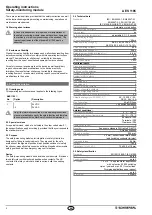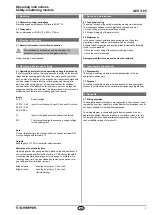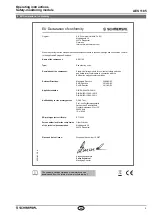
3
AES 1185
Operating instructions
Safety-monitoring module
EN
3. Mounting
3.1 General mounting instructions
Mounting: snaps onto standard DIN rails to EN 60715.
3.2 Dimensions
Device dimensions (H/W/D): 75 x 22,5 x 110 mm
4. Electrical connection
4.1 General information for electrical connection
The electrical connection may only be carried out by
authorised personnel in a de-energised condition.
Wiring examples: see appendix
5. Operating principle and settings
5.1 Operating principle after the operating voltage is switched on
If a safety guard is opened, the microprocessors swithc off the internal
relays and the enabling path is opened. The relays are only switched
back on, when the function of the relays and all connected components
could be tested. During a start-up cycle (opening and closing of at
least one of the safety guards), all individual faults of the switches,
cables/wires and the safety-monitoring module, which could lead to a
dangerous situation, are detected. This always causes the relays to be
switched off and therefore the enabling path to be opened.
Inputs
A1, A2
Supply voltage
S1-S14 / S22,
S2-S14 / S22,
S3-S14/S22
Inputs for switches with one NC and one NO contact
X1
Input for the feedback of the external contactors.
S13
The terminal supplies the necessary supply voltage
for the safety switch.
Note
If one or two safety guards are connected, the unused terminasl S22
must be bridged with terminal S13.
Outputs
Enabling path 13-14 NO contact for safety functions
Extension of enable delay time
On safety guards with strong residual vibrations, the end position of a
non-contact position switch is often "overrun". This causes the safety-
monitoring module to generate an error message. To avoid this, the
"enabling delay time" can be extended by removing the device cover
and setting an internal bridge (jumper).
Bridge closed:
enabling delay time = 1.0 second
Bridge closed:
enabling delay time = 0.1 second
(factory setting)
6. Set-up and maintenance
6.1 Functional testing
The safety function of the safety-monitoring module must be tested.
The following conditions must be previously checked and met:
1. Correct fitting of the safety-monitoring module
2. Fitting and integrity of the power cable
6.2 Maintenance
In the case of correct installation and adequate use, the safety-
monitoring module features maintenance-free functionality.
A regular visual inspection and functional test, including the following
steps, is recommended:
• Check the correct fixing of the safety monitoring module
• Check the cable for damage.
Damaged or defective components must be replaced.
7. Disassembly and disposal
7.1 Disassembly
The safety monitoring module must be disassembled in the de-
energised condition only.
7.2 Disposal
The safety monitoring module must be disposed of in an appropriate
manner in accordance with the national prescriptions and legislations.
8. Appendix
8.1 Wiring examples
The application examples shown are suggestions. They however do not
release the user from carefully checking whether the switchgear and its
set-up are suitable for the individual application.
The wiring diagram is shown with guard doors closed and in a de-
energised condition. Inductive loads (e.g. contactors, relays, etc.) are
to be provided with suitable interference suppression circuitry. Do not
connect additional loads to terminal S..
























